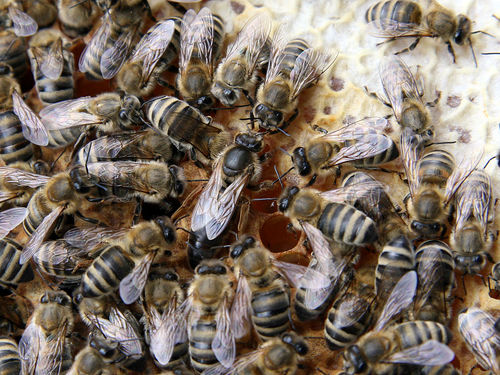Beekeeping
Main > Food and Agriculture > Beekeeping
It is beyond the scope of this wiki to provide full instructions on beekeeping, and there are already a lot of excellent resources online (see links below).
We are interested in open-source designs of beekeeping equipment. We have completed an Open Source Honey Extractor. We are assessing the feasibility of 3D printed beehives, which may reduce the barrier to entry to beekeeping.
Bees integrate well with the scalable, local food systems we are helping develop. Beehives in a fruit orchard will, at a conservative estimate, increase yields by one-third. This is the main benefit of bees to a farmer. As well as that, you can expect about 12kg of honey per hive every summer.
Vertical top-bar hives
From Abe at http://velacreations.blogspot.com/ :
On the beehive, this is not a tropical version, but year-round version that has seen winters in Montana and summers in Mexico. Take a look at http://www.biobees.com for more information on maintaining this type of hive. He also has a great forum.
If you have really cold winters, you might consider a Warré hive, which is basically the same thing as my barrel hive, but vertical. You still have the top bars in there, no frames, no foundation, etc. Very simple.
- You can download Warré's book, Beekeeping For All, here - see the "Free Downloads" on the right. According to Abbé Warré: "beekeeping is a moral activity, as far as it keeps one away from cafés and low places". Watch out for them cafés!
On a side note about the hives. I wouldn't convert your current hives. I would make 2 top bar hives, and use them as comparison, especially for disease resistance, maintenance needs, and things along those lines. Don't compare honey output alone, compare input vs output, and I think you'll find that top bar hives, (horizontal or vertical) require a lot less input for the amount they produce. The vertical top bar hives (Warre) are only handled 2 times a year, and horizontals are usually handled maybe 2 times a month during honey production (this is basically removing a few bars of honey, checking to make sure everyone is ok, and that's it)
Split your hives in the spring, and put the splits in the new design. Then, on year 2, you can make some comparisons.
Some benefits:
- Less risk of mites and Varroa
- Bees are less stressed, making them calmer and easier to handle
- No need for antibiotics and other medicines, which means cheaper
- Cheaper to construct new hives (the barrel hive can be made for less than $20)
- No need for an extractor, just crush and press, very simple
- No heavy lifting - you lift one bar at a time, not the whole super
I would definitely research Warré hives, but the horizontal top bar hives are good as well. The barrel version is similar to a Kenyan Top Bar hive, which just means it has sloping sides.
You can convert your current hives into top bars but it will be a lot of work. Best to try out a few top bar hives on their own, see if they work for you for a couple of years, then you can convert those old ones or just phase them out.
I like the top bar design because it is less stressful to bees, and since I have Africanized bees, less stress means they don't want to kill me, which is a good thing. Removing one bar at a time exposes the bees a lot less than an entire super. So, it doesn't make them go into defensive mode.
Anyway, do some googling on top bar hives. Especially these sites:
Horizontal top-bar hives
- How to build a "Honey Cow" beehive: http://makeprojects.com/Project/Your-Own-Honey-Cow/539/1. Not a great hive for maximal honey yield, but as good as any for pollination.
- Yield of a top bar hive is approximately 1/2 that of a top bar hive - 3-5 gal vs 5-10 gal (one gallon is almost 12 lb) - [1]
Treehugger article: Beepods Bring Back an Old Design for Better Beekeeping
Links
- ATTRA: Beekeeping/Apiculture- awesome resource
- ATTRA: Beekeeping/Apiculture- even better, lots of links and works cited
- North Central Integrated Pest Management Center
- MU Extension pest monitoring network
